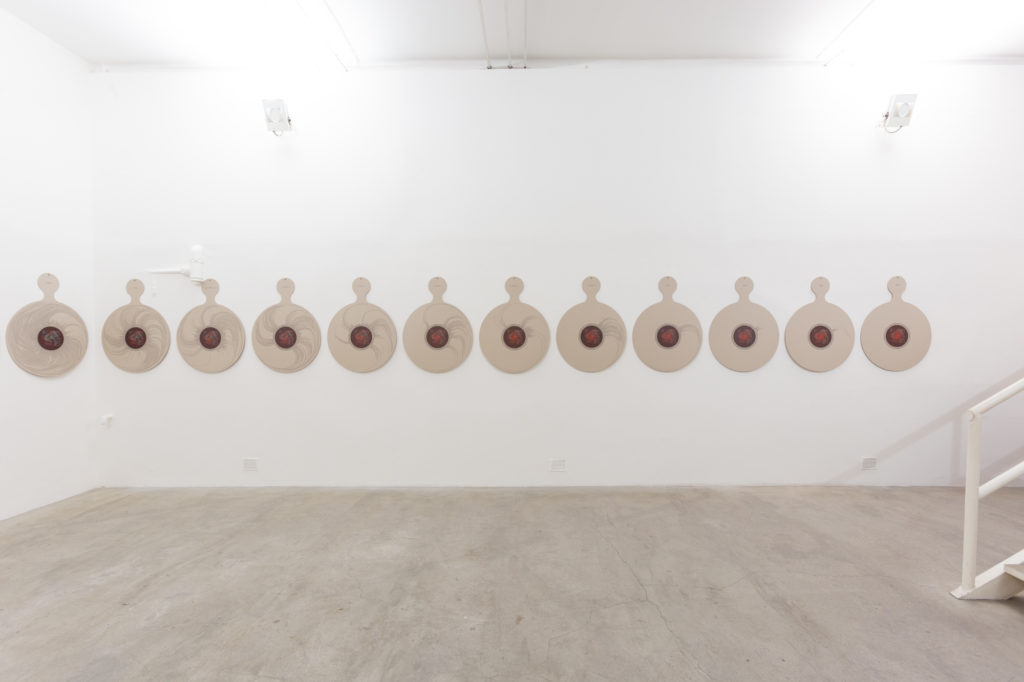bone setting by zbyněk baladrán
description of the series exhibited in trieste
text by the artist

View of the exhibition at the Studio Tommaseo (photo by Francesco Chiot)
algebra—from al-jabr. Reunion of broken parts; bonesetter; referring to reduction and balancing, the cancellation of like terms on opposite sides of the equation.
“We aren’t ten, we aren’t a hundred, we challenge the state to count us right!” – Chant shouted at demonstrations in Guatemala (quote from Who Counts? by Diane M. Nelson).
As Friedrich Kittler once remarked, war is the mother of all things – it led to the creation of most technological inventions. This makes us think about the nature of our technological world and understand the tools we use. To speak simply: our civilisation is a society of warriors and their descendants, who profit from permanent military conflict, whether open or concealed. Not even artworks could be realised without the aid of military technology. The boom of digital technology is founded upon the development of weaponry systems. Bone Setting is no exception. The interconnection of the military-industrial complex in the USA creates a global paradigm, as well as the umbrella part of the world hides under, including the space we live in. Thanks to a system of exporting war around the world, the United States has become the greatest war machine, and this despite the fact it hasn’t declared any wars. This applied militarism, along with the effects of the free market, also transforms the language we use. The invention of terms such as “humanitarian bombing” or “humanitarian sanctions” bends and adapts the original meaning of the words and creates the newspeak of the “free” world. It has transpired that democracy can only be “exported” as a product under unequal conditions, i.e. with the assistance of heavy military equipment, enriched-uranium missiles, and the “correct” language.
The United States Department of Defense regularly publishes dictionaries in which the world is translated into and embodied in military terminology. This constantly expanding compendium of acronyms, names, and new words is a handbook reflecting the dominion and aims of what is now the strongest empire in the world. On the basis of these traces and other statements, we can discern the emerging trajectories influencing the future of mankind. After a hundred years of an undoubted military hegemony spreading its influence around the world, the empire is preparing to export its internal problems into the external world. If you want peace, prepare for war – this maxim is taken from Vegetius’ military handbook, written in the late Roman Empire, which the United States have always followed with predictable regularity. The thirteen successive temporal diagrams are a reflection and development of previous ideas. They were created during the state of emergency in the spring of 2020. They were inspired by the strong emotions and materialised fears brought about by the global pandemic. Emotions are messengers of the future, as Timothy Morton put it in a “lockdown” interview. They announce as-yet unarticulated and un-understood realities of our transforming present. I attempted to manifest this fear through the drawings made with a bone. Every bone becomes a mailbox; an address in a world in which data is the fate of its address. I transformed the contents of a dictionary of military terms into cases composed of a certain number of bones. The visual form arises from the alphabetic arrangement and allows us to see, in its own strange way, how taxonomies reflect social hierarchies whilst also unwillingly depicting the machinery of propaganda and expressing normative power.
Paul Virilio described one of the current aspects of globalisation and the emerging planetary consciousness as a synchronisation of emotions. In a single instant, we can all feel the same terror, the same anxiety about the future, or the same panic. Virilio claims the world is moving from a standardisation of opinion to a standardisation of emotion, from freedom of the press to a synchronisation of emotions. This work is a dark foretaste of this process, whatever it may lead to.
extract from Zbyněk Baladrán